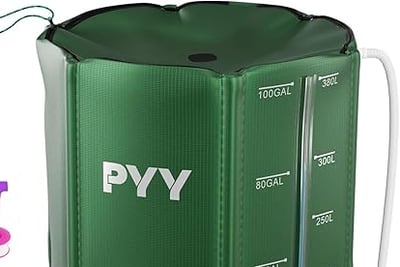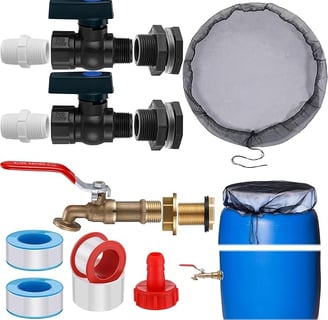Harnessing Nature: The Benefits and Challenges of Rainwater Collection Systems
7 min read


Introduction to Rainwater Collection Systems
Rainwater collection systems serve as effective solutions for capturing and utilizing precipitation, transforming an abundant natural resource into a valuable asset for various applications. These systems are designed to gather rainwater from surfaces such as rooftops, driveways, and other impermeable areas. The fundamental components of a rainwater harvesting system include collection surfaces, storage tanks, filtration systems, and distribution mechanisms. Collectively, these elements facilitate the efficient harnessing of rainwater, making it available for different uses.
The collection process begins when rainwater falls onto the designated surface, where it is directed through gutters and downspouts into a storage tank. The storage tank plays a crucial role in rainwater collection systems, serving as a reservoir that holds the captured rainwater until it is needed. These tanks can vary in size and material, ranging from large underground cisterns to smaller above-ground barrels, depending on the volume of water required and the available space. A well-designed system ensures that the collected water is clean and safe for utilization, often including filtration components that remove debris and contaminants before the water is stored.
In addition to storage, distribution methods are an essential aspect of rainwater collection systems. Gravity feed, pumps, and gravity-fed drip systems can be employed to deliver harvested rainwater to where it is needed, such as irrigation for gardens, flushing toilets, or even potable uses with appropriate treatment. This versatility highlights the practicality of a rainwater harvesting system in various contexts, from urban settings where space and resources are limited to rural environments where water independence is vital.
Ultimately, rainwater collection systems offer numerous benefits by promoting sustainable practices, reducing dependency on municipal water supply, and contributing to overall water conservation efforts. Understanding how these systems function sets the foundation for evaluating their significance in improving water management practices across diverse environments.
The Economic and Environmental Benefits of Rainwater Harvesting
Rainwater harvesting presents numerous economic and environmental advantages, making it a vital practice for sustainable living. Implementing a rainwater collection system allows households and businesses to significantly reduce their dependence on municipal water supplies, leading to substantial cost savings on water bills. By capturing and utilizing rainwater for non-potable applications such as irrigation, toilet flushing, and washing clothes, users can see a marked decrease in their water consumption. This reduction is particularly valuable in regions experiencing water scarcity, where demand for water often exceeds supply, resulting in increased utility rates.
In addition to financial savings, rainwater harvesting systems also play a crucial role in minimizing stormwater runoff. Traditional urban landscapes often suffer from impermeable surfaces that prevent water from being absorbed into the ground, leading to flooding and erosion. By collecting rainwater, these systems help to alleviate the burden on drainage systems and reduce the risk of waterlogging during heavy rainfall events. Furthermore, capturing rainwater can decrease the amount of pollutants and debris that enter nearby waterways, thereby contributing to improved water quality in local ecosystems.
The positive environmental impacts of rainwater harvesting extend beyond immediate cost savings and flood mitigation. As communities adopt rainwater collection practices, they contribute to preserving local biodiversity. Harvested rainwater can be used to support green spaces, gardens, and landscaping, which provide habitats for various species and enhance urban environments. This practice not only fosters a connection between communities and nature but also encourages a shift toward more sustainable and eco-friendly lifestyles. Ultimately, embracing rainwater harvesting is a proactive step toward safeguarding vital water resources while promoting ecological balance and sustainability.
Potential Drawbacks of Rainwater Collection Systems
While rainwater collection systems offer numerous benefits, there are several potential drawbacks and challenges that individuals and communities should consider. One of the primary concerns is the initial setup cost associated with the installation of a rainwater harvesting system. The upfront investment can vary significantly, influenced by factors such as the size of the system, the materials used for construction, and any additional features desired, such as filtration or storage capacity. For some households, these expenses may pose a considerable financial barrier, especially if funds are limited.
Moreover, rainwater harvesting systems require ongoing maintenance to ensure their effectiveness and safety. Regular inspections and cleaning are necessary to prevent blockages, algae growth, and contaminants in the collected water. Failure to maintain these systems can lead to reduced water quality, making compliance with health and safety standards challenging. Additionally, these maintenance tasks may require time and expertise that not all homeowners possess, potentially leading to further complications if neglected.
Legal regulations also play a crucial role in the viability of rainwater collection systems. In certain regions, there may be restrictive laws regarding the collection and use of rainwater, which can complicate or even prohibit installation for residential or commercial purposes. Understanding local policies is essential for potential users and may deter some from pursuing an otherwise beneficial rainwater harvesting system. These regulations can vary widely, so prospective users must stay informed about their rights and responsibilities related to rainwater collection.
In summary, while rainwater collection systems provide a sustainable alternative water source, prospective users must carefully consider the associated costs, maintenance demands, and legal implications to make an informed decision.
Why Saving Water is Essential
Water is an indispensable resource, essential not only for human survival but also for the sustainability of ecosystems and agriculture. In recent years, the critical importance of water conservation has gained attention, largely due to escalating global water scarcity issues. According to the United Nations, over 2 billion people currently live in countries experiencing high water stress, a situation that could worsen with projections indicating a 40% shortfall in freshwater supply by 2030.
Climate change further exacerbates this problem, contributing to unpredictable weather patterns that lead to both severe droughts and flooding. Regions that were once abundant in natural water sources are witnessing drastic reductions, with traditionally fertile areas becoming arid. This reality compels us to rethink our water management strategies, emphasizing the essential role of rainwater collection systems in sustainable practices. These systems can capture and store rainwater, providing an alternative source that alleviates pressure on conventional water supply methods.
The role of individual actions in combating water scarcity cannot be overstressed. By adopting water-saving practices such as rainwater harvesting, communities can reduce dependence on municipal water supplies, thereby fostering resilience against potential future shortages. Furthermore, these practices contribute to preserving local aquifers, promoting groundwater recharge, and enhancing biodiversity. Both moral and practical imperatives drive the need for eco-conscious approaches to conservation. Cumulatively, if individuals commit to saving water, the impact can be significant, leading to healthier ecosystems and a more sustainable future.
As society faces increasing challenges related to freshwater resources, the urgency for water conservation has never been clearer. It is not merely a personal choice or lifestyle preference but a collective responsibility that affects generations to come.
Practical Uses for Collected Rainwater
Harvested rainwater is a valuable resource that can be utilized in various practical applications, promoting sustainability and resource conservation in our daily lives. One of the most common uses is for irrigation in gardens and landscaped areas. Utilizing collected rainwater for watering plants not only conserves tap water but also provides natural hydration devoid of the chemicals typically found in municipal supplies. This approach can lead to healthier plants and reduced water bills.
Another effective application for collected rainwater is in household toilets. Flushing toilets accounts for a significant portion of domestic water consumption, and by redirecting rainwater to this purpose, homeowners can significantly decrease their reliance on treated water. This simple system not only lowers water costs but also engages households in environmental stewardship, making them more conscious of water usage.
In addition to gardening and sanitation, rainwater holds great potential for washing vehicles. Using rainwater for car washes minimizes the consumption of treated water while providing a spot-free clean, as naturally soft rainwater often leaves fewer deposits than hard tap water. Furthermore, collected rainwater can be employed creatively in landscaping projects, such as filling ornamental ponds or supporting water features that enhance outdoor aesthetics.
Moreover, rainwater can serve as a source for pressure washing outdoor surfaces, cleaning decks, and maintaining patios without straining water resources. From enhancing sustainable farming to improving the efficiency of daily household tasks, the versatility of harvested rainwater is truly inspiring. By adopting these eco-friendly practices, individuals and communities can significantly contribute to water conservation efforts, fostering a more sustainable future.
Installation and Maintenance of Rainwater Harvesting Systems
The installation of a rainwater harvesting system involves several important steps that contribute to its efficiency and longevity. First, selecting appropriate materials is crucial. A rainwater collection system generally requires gutters, downspouts, pipes, a storage tank, and a filtration system. When choosing materials, it’s advisable to opt for non-toxic options that are compatible with potable water standards if you intend to use the water for drinking or cooking purposes. For instance, polyethylene or fiberglass tanks are commonly used due to their durability and resistance to corrosion.
Next, proper filtration is essential to ensure that collected water is free from debris and contaminants. Installing a first-flush diverter helps remove the initial quantity of water that may contain contaminants from the roof. Additionally, incorporating a leaf guard on gutters will minimize the entry of leaves and other organic material into the system. Regularly cleaning the gutters and filters is necessary to maintain system efficiency, preventing clogging and promoting optimal flow.
Once the system is in place, routine maintenance checks must be performed to maintain functionality. This includes inspecting tanks for any signs of algae growth or leaks and ensuring that the filtration elements remain effective. It is advisable to drain and clean the storage tank at least once a year to prevent stagnant water and contamination. Furthermore, installing a water level indicator can help monitor the tank's capacity, allowing for better management of rainwater resources.
To optimize the system's efficiency, maintain an accessible maintenance schedule and take advantage of any local incentives or rebates for rainwater harvesting. By adhering to these guidelines, rainwater harvesting can be a sustainable and effective way to harness nature, providing a reliable water source while contributing to conservation efforts.
Conclusion and Future Perspectives
Rainwater collection systems have emerged as a vital solution for water conservation, offering significant benefits for both individuals and communities. By effectively harnessing natural rainfall, these systems not only reduce dependence on municipal water supplies but also contribute to substantial cost savings over time. The ability to utilize rainwater for irrigation, non-potable household needs, and even potable use in some regions underscores the effectiveness of such systems in promoting sustainability.
Throughout this discussion, we have highlighted the key advantages of rainwater collection, including environmental benefits, mitigation of urban flooding, and enhanced water security. However, the adoption of these systems does come with challenges, such as the initial installation costs and maintenance requirements. Addressing these hurdles through educational outreach and financial incentives can foster greater acceptance of rainwater systems among homeowners and businesses alike.
Looking to the future, it is essential to recognize the growing significance of water sustainability as urban areas continue to grapple with increasing demand and climate variability. Technological advancements are poised to transform rainwater collection methods, making them more efficient and user-friendly. Innovations such as smart sensors, advanced filtration systems, and even integration with existing infrastructure can significantly enhance the functionality of rainwater systems.
The potential for wider adoption in urban settings presents an opportunity for cities to create comprehensive water management strategies that include rainwater harvesting as a key component. By embracing sustainable practices and exploring new technologies, communities can ensure a resilient water supply that can meet the needs of future generations. In summary, rainwater collection systems represent not just an individual solution but a collective step towards a more sustainable and water-conscious future.











